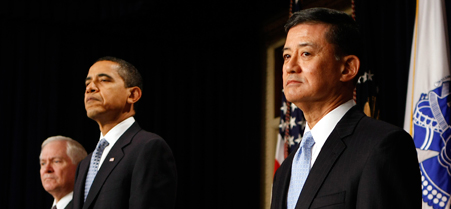Obama backs joint VA-Defense electronic health records
Two departments have been working on and off for decades on common standards.
 President Obama, with Defense Secretary Robert Gates, left, and VA Secretary Eric Shinseki, said "It's time to give our veterans a 21st-century VA."
President Obama, with Defense Secretary Robert Gates, left, and VA Secretary Eric Shinseki, said "It's time to give our veterans a 21st-century VA."
President Obama put the power of his office behind development of a joint Defense-Veterans Affairs electronic health record system at a White House press briefing Thursday with Defense Secretary Robert Gates and VA Secretary Eric Shinseki.
"It's time to give our veterans a 21st-century VA," the president said. That, he added, includes a "unified lifetime electronic health record for members of our armed services that will contain their administrative and medical information -- from the day they first enlist to the day that they are laid to rest."
"Currently, there is no comprehensive system in place that allows for a streamlined transition of health records between DoD and the VA," Obama said. "That results in extraordinary hardship for an awful lot of veterans, who end up finding their records lost, unable to get their benefits processed in a timely fashion."
Defense cares for 9.2 million patients in both its own 63 hospitals and 826 clinics and in partnership with civilian doctors through its TRICARE insurance system. VA treats 55 million veterans a year at its more than 1,400 hospitals and clinics.
Rep. Bob Filner, D-Calif., chairman of the House Veterans Affairs Committee, said he views development of joint electronic health records as a "matter of life or death." Without a complete record, VA clinicians might not have the information from Defense needed to properly treat a patient, he said.
Rep. Steve Buyer, R-Ind., the committee's ranking member, said he hoped Obama's announcement would put an end to what he described as "20 years of bureaucratic infighting" over development of joint records.
Tom Munnecke, a San Diego-based philanthropist who helped develop the Veterans Health Information System and Technology Architecture (VistA) electronic health record system while a VA employee in 1978, said Defense and VA agreed to start working on an electronic health record in 1998 "and nothing has happened since then."
Robert McFarland, who served as VA's chief information officer from January 2004 to April 2006, said joint-record concept is "a good thing and long overdue."
Glen Gardner Jr., national commander of the Veterans of Foreign Wars, said a single electronic record system will help ease the transition of millions of servicemen and women from Defense into the VA system, increase their access to care and benefits, and protect personal data.
Munnecke, who also helped develop Defense's Composite Health Care System, now known as AHLTA, in the 1980s at SAIC in San Diego, said Obama's announcement marks the first time a president has put his clout a behind development of a joint electronic record. But following through on the pledge, he added, will require strong leadership and program management.
Obama's announcement contained few details. Buyer said he looked forward to learning more about the administration's proposal, including a timeline for development and deployment.
"This connection between the Defense and VA health systems is long overdue," said Dr. Charles Frazier, vice president for clinical innovation at the Riverside Health System in the Hampton Roads area of southern Virginia, home to multiple Army, Navy and Air Force facilities. "It obviously makes a lot of sense."
Frazier said he had just treated a patient who receives care from both Defense and VA, and it "would it be to his obvious benefit" if clinicians could gain access to records from both departments.
Defense and VA started developing a bidirectional health information exchange in 2004. In July 2008, top officials of the Military Health System told Nextgov that Defense and VA had kicked off a project to develop an electronic health record system architecture by the end of 2009 to serve both departments.
Charles Campbell, chief information officer of the Military Health System, said at the Healthcare Information and Management Systems Society conference in Chicago this week that joint Defense-VA systems have records on 3.3 million patients and handle queries on about 60,000 patients a week.
Campbell said an AHLTA interface unveiled last month was based on the VistA interface and was designed to serve both departments.
NEXT STORY: VA Logo Upgrade On Schedule



